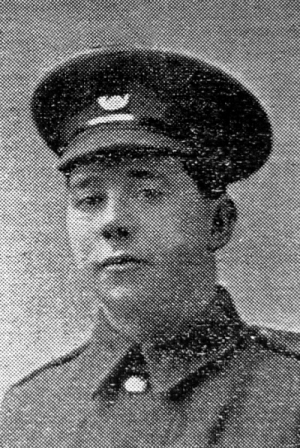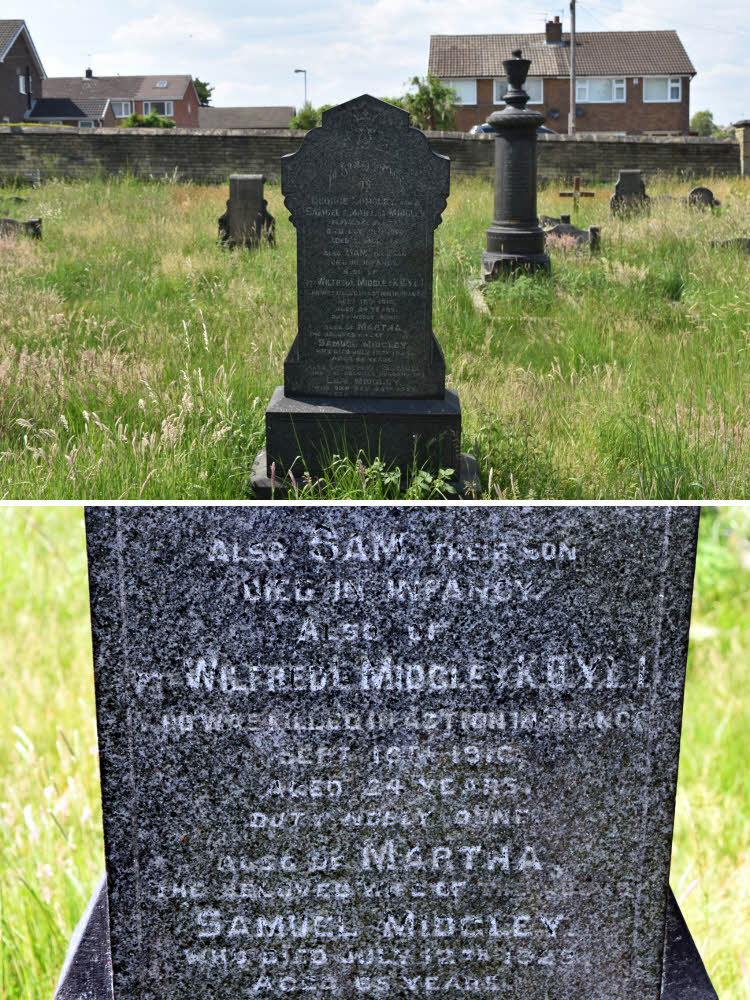
Wilfred Longley Midgley was born in Ossett in 1892, the second child and second son of Samuel Midgley and his wife Martha, (nee Bickerton), who were married in September 1887 in the Pontefract Registration District. Samuel was born in Millbridge, near Birstall and Martha was from Hensall near Selby.
The couple had six children from their marriage, but sadly two children died before April 1911. Wilfred, was baptised at Ferry Fryston, St Andrew, Pontefract on the 27th March 1892. In 1901, the family were living at Shepherd Hill, Flushdyke, where Samuel was working as an engine tenter, but by 1911 the family had moved again to Balne Lane, Wakefield, where Wilfred was working as a boiler fireman in a worsted mill and his father, Samuel Midgley, was a brickworks manager at Roundwood, Ossett.
Wilfred Longley Midgely’s army service record has not survived, but it is known that he enlisted in October 1915 at Wakefield and joined the 7th Battalion of the King’s Own Yorkshire Light Infantry Regiment. His service number was 25527, and he embarked for France in May 1916. Wilfred was posthumously awarded the British and Victory medals. Although he enlisted in 1915, he did not serve overseas before the 31st December 1915, and did not qualify for the 1914/15 Star.
7th (Service) Battalion of KOYLI was Formed at Pontefract on the 12th September 1914 as part of the Army Orders authorising Kitchener’s Second New Army, K2 and attached to 61st Brigade in 20th (Light) Division. Early days were somewhat chaotic, the new volunteers having very few trained officers and NCOs to command them, no organised billets or equipment. The units of the Division first assembled in the Aldershot area with brigades at Blackdown, Deepcut and Cowshott. Artillery was particularly hard to come by, but eventually twelve old guns arrived from India in February 1915. When, in the same month, the Division moved to Witley (7th), Godalming and Guildford, the artillery had to go by train as there were insufficient harnesses for the horses. Another move was made, to Salisbury Plain (7th), in April 1915.
The Division was inspected by King George V at Knighton Down on the 24th June 1915, by which time all equipment had arrived and the Division was judged ready for war.
On the 24 July 1915 they landed at Boulogne and on the 26th July 1915, the Division completed concentration in the Saint-Omer area, all units having crossed to France during the preceding few days. Early trench familiarisation and training took place in the Fleurbaix area. The Division served on the Western Front for the remainder of the war, taking part in many of the significant actions.
The 7th KOYLI were in reserve and support positions during the Guillemont operations on the Somme in late August 1916. They moved to Méaulte on the 6th September, then to Méricourt on the 8th September, to Sandpit Camp on the 12th September, to Citadel Camp on the 14th September and then to Trônes Wood on the 15th September to take part in the Lesboeufs operations on the 16th September when a single German shell fell on the 7th KOYLI HQ, killing all the Headquarters officers and 30 other ranks were either killed or wounded. Private Wilfred Midgley was one of the other ranks who were killed by that well-aimed German shell on the 16th September.1
The “Ossett Observer” 2 had this obituary for Wilfred Midgley:
“Flushdyke Footballer Killed In Action – A well-known young man in the Flushdyke and Roundwood districts in the person of Private Wilfred L. Midgley (24), of the King’s Own Yorkshire Light Infantry, has lost his life in the recent operations in Picardy. He was the son of Mr. and Mrs Samuel Midgley, who until a few years ago resided at Roundwood, where Mr. Midgley was the manager of the brickworks. The family now reside in Silcoates-street, Wakefield, but since their removal Wilfred has kept up his close association with Flushdyke. He enlisted in October last year, and at the time worked at Messrs. Phillips’ mill at Flushdyke. Always interested in sport, he was a playing member of the Flushdyke Bethel Cricket Club and the Flushdyke Albion Association Football Club, being a member of the latter team when it won the Ossett and District League Championship in 1913-14. Since going into training as a soldier Private Midgley had been chosen to play in representative regimental football matches, and had also won a prize in a cross-country race. He went out to France towards the end of May, and has written several cheery letters to his relatives and friends, one, dated the 13th inst., being received from him as recently as Saturday last. The same day, however, and official intimation was received from headquarters stating that he was killed in action on the 16th inst.”
A follow-up report in the “Ossett Observer”, a week later provided a few more details:
“Flushdyke Soldier’s Death – The mother of Private W. L. Midgley, formerly of Flushdyke, whose death was reported last week, has received a letter from the major commanding his company, stating that he was struck by a shell on the 16th inst., and killed instantly. The officer says that the deceased had recently been appointed as an orderly owing to his smartness and good conduct. ‘It may be some consolation’, he adds, ‘ to know that he died a soldier’s death in action. His body lies buried near the spot where he fell.’ A memorial service is to be held at the Bethel Congregational Chapel to-morrow.”
Private Wilfred L. Midgley, aged 25 years, son of Samuel and Martha Midgley, of 11, Silcoates Street, Wakefield, died on the 16th September 1916. He is is remembered on Pier and Face 11C and 12A at the Thiepval Memorial 3, Somme, France. The Thiepval Memorial can be found on the D73, next to the village of Thiepval, off the main Bapaume to Albert road (D929).
On 1 July 1916, supported by a French attack to the south, thirteen divisions of Commonwealth forces launched an offensive on a line from north of Gommecourt to Maricourt. Despite a preliminary bombardment lasting seven days, the German defences were barely touched and the attack met unexpectedly fierce resistance. Losses were catastrophic and with only minimal advances on the southern flank, the initial attack was a failure. In the following weeks, huge resources of manpower and equipment were deployed in an attempt to exploit the modest successes of the first day. However, the German Army resisted tenaciously and repeated attacks and counter attacks meant a major battle for every village, copse and farmhouse gained. At the end of September, Thiepval was finally captured. The village had been an original objective of 1 July. Attacks north and east continued throughout October and into November in increasingly difficult weather conditions. The Battle of the Somme finally ended on 18 November with the onset of winter.
In the spring of 1917, the German forces fell back to their newly prepared defences, the Hindenburg Line, and there were no further significant engagements in the Somme sector until the Germans mounted their major offensive in March 1918.
The Thiepval Memorial, the Memorial to the Missing of the Somme, bears the names of more than 72,000 officers and men of the United Kingdom and South African forces who died in the Somme sector before 20 March 1918 and have no known grave. Over 90% of those commemorated died between July and November 1916. The memorial also serves as an Anglo-French Battle Memorial in recognition of the joint nature of the 1916 offensive and a small cemetery containing equal numbers of Commonwealth and French graves lies at the foot of the memorial.

Above: The Midgley grave at St. John’s Methodist Chapel showing the memorial to Wilfred Longley Midgley, the son of Samuel Midgley. Picture courtesy of Lisa Jennings.
References:
1. “Tracing British Battalions on the Somme”, by Ray Westlake, Pen and Sword Books, 2009 and 2011, ISBN: 978-184415-885-0
2. “Ossett Observer”, 30th September 1916